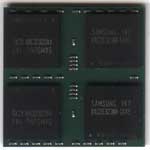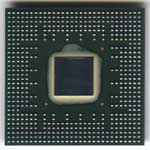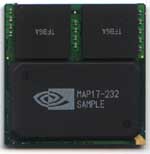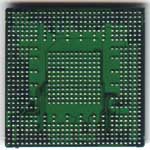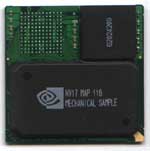
Original Link: https://www.anandtech.com/show/933
There is a general consensus in the world today that monopolies are bad. Recent years have seen the US Department of Justice file go after Microsoft for anti-competitive practices and the European Commission block the proposed merger of Sprint and WorldCom, both for good reasons. The creation of monopolies are associated with a number of free market problems, including price inflation and lack of innovation.
It is for these reasons and more that we encourage competition in the computer industry. On top of the pricing issues, a secure market share gives a company the luxury of being lazy, and laziness is something we don't need in the ever-growing world of computers. With the growing role each component on a computer plays, a company with monopoly-style control over a specific component could stifle innovation throughout the whole technology field. Healthy competition drives companies to provide the best product for the consumer, at least that is what Adam Smith has us believe.
Because lack of competition is generally bad, and because we like to see a good battle, we could not have been more excited when NVIDIA decided to expand its attack on ATI by taking on the company's mobile division. Prior to NVIDIA entering the market, 3D based solutions for mobile computing were almost exclusively produced by ATI. The company had large wins with many OEMs and essentially dominated the mobile graphics industry; NVIDIA threatened to change all that.
Competition between the two companies on the mobile side has only increased since NVIDIA entered the mobile market almost two years ago. The industry has seen a new generation of mobile video solutions appear from each company, resulting in what could be one of the largest advancements in the mobile computing world: bringing desktop-like 3D abilities to laptops.
At the end of August last year, ATI announced the availability of their latest mobile graphics part, the Mobility Radeon 7500. NVIDIA punched back at the end of November, announcing their GeForce4 Go series mobile graphics chips. A month ago, we took a look at the Mobility 7500 in our Compaq Presario 2800 review. Today we take a look at the GeForce4 Go with a Dell machine running a GeForce4 440 Go.
The Chip
Like the jump made by ATI from the Mobility Radeon chip to the Mobility Radeon 7500, the jump NVIDIA took going from the GeForce2 Go to the GeForce4 Go was nothing short of impressive. Let's see what is behind NIVIDA's latest mobile solution.
You may recall that both ATI and NVIDIA base their mobile graphics parts on modified versions of desktop chips. This makes the most sense for the companies, as new desktop technology can be adapted for mobile use. The ATI Mobility Radeon 7500 was based off the desktop ATI Radeon 7500 core. NVIDIA based the GeForce4 Go chips on the GeForce4 MX line of cards.
The GeForce4 Go series is made up of three products: the GeForce4 410 Go, the GeForce4 420 Go, and the GeForce4 440 Go. Each is based off a modified version of the the GeForce4 MX core with the only difference between the chips being in memory size/speed and core speed. There are actually two different breeds of two of the three chips but we'll get to that in a minute.
The entire GeForce4 Go series chips are built on a 0.15 micron process, just like the NV17 that they are based on. Not only did this decrease power consumption compared to the older 0.18 micron GeForce2 Go, it also allowed NVIDIA to pack more components into a tight space; both items crucial for mobile chip success. Like the GeForce4 MX desktop chips, the GeForce4 Go chips feature two pixel pipelines that are able to apply two textures per pipeline (creating half the theoretical fill rate of an equivalently clocked desktop GeForce4).
The chips also feature the lightspeed memory architecture II that was first introduced in the GeForce4 line, but like the GeForce4 MX chips, the LMA II implementation has 2 x 64-bit load balanced memory controllers (compared to the GeForce4's 4 x 32-bit memory controllers). Also like the desktop GeForce4 MX, the GeForce4 Go chips feature the Accuview AA engine, T&L engine, nView support, and an improved Visibility Subsystem.
What is missing from the GeForce4 Go? Well, the same things that are missing from the GeForce4 MX line of cards. This includes the nfiniteFX engine, which leaves the GeForce4 Go without DirectX 8 pixel shaders and only limited support for vertex shaders. This puts the feature specs right in line with the Mobility Radeon 7500 which also does not include DirectX 8 pixel and vertex shader support.
Of course, since the GeForce4 Go is a mobile solution, some things had to be added to the core to make it ready for use in a notebook. By far the largest chip difference between the GeForce4 Go chips and the GeForce4 MX is the addition of PowerMizer technology.

PowerMizer is a hardware and software power saving solution that helps decrease the battery drain of the graphics chip and thus increase battery life. PowerMizer is now on its second implementation on the GeForce4 Go chips, and things have changed for the better. As one would suspect, a powerful mobile graphics solution has the potential to drain a significant amount of power. To address this issue, PowerMizer attempts to conserve as much power as possible. This is done using the following methods.
First off, the GeForce4 Go chips have the ability to dynamically clock gate. This means that blocks of the chip that are not being used can be turned off. For example, when the GeForce4 Go is only drawing a 2D environment on the notebook's LCD panel, the only parts of the chip that would be active are the 2D engine, the LVDS and the memory interface. The 3D engine, video processing engine and the display encoders would all be turned off, decreasing the power consumption of the chip.
The GeForce4 Go chips also support dynamic clock and voltage scaling. This scaling is done both automatically by the chip depending on the situation as well as by a user determined setting. The automatic portion of the dynamic clock and voltage scaling allows the GeForce4 Go to significantly reduce its memory and core clock speed depending on what it is doing. When in a static 2D environment, the GeForce4 Go automatically sets itself down to the lowest clock speed possible. We were told that in static 2D mode, the GeForce4 Go operates at an 85MHz core speed and a memory speed somewhere between 100MHz and 125MHz depending on the memory type used. Obviously, the chip does not need to be running at full speed while in 2D mode and thus battery life is saved by decreasing the clock speeds and voltages that the GeForce4 Go is running at. As soon as 3D rendering is required the GeForce4 Go clocks up to a speed which is determined by the user controlled setting.
PowerMizer allows the user to control how fast the GeForce4 Go chip runs while performing 3D tasks. Controlled via a driver control pane, PowerMizer allows the graphics chip to run at one of three settings: Maximum Performance, Balanced and Maximum Power Savings. OEMs are in control of exactly how fast the graphics chip runs each of the three stops but the feature gives the GeForce4 Go the potential to run at maximum speed while in maximum performance mode, minimum speed while in maximum power savings mode and a speed between while in balanced mode. Since the feature is user controllable and can be changed on the fly, the GeForce4 Go will only eat up as much power as the user wants. For example, one may set the chip to run at maximum performance while doing some gaming on AC power, balanced performance for some mobile gaming on battery power and maximum power savings while watching a DVD. Not only are the clock speeds of the chip changed at the various settings so are the voltages being supplied to the chip, resulting in extra power savings.
You may notice that PowerMizer technology in the GeForce4 Go chips is very similar to the Powerplay technology in the Mobility Radeon 7500 the in terms of features. The two also share the same problem when it comes to implementation of the user controlled aspects of their power savings technology. Many OEMs are choosing to not ship with the user selectable portion enabled due to a number of issues, one of which being the added headache of supporting yet another notebook feature. Both NVIDIA and ATI do promise that OEMs are becoming more comfortable with the idea and that notebooks with the software selectable performance sliders should be available soon.
The PowerMizer feature set looks impressive. We would have to wait until testing to see exactly how much difference it made.
Like we mentioned before, the GeForce4 Go chips are available in a few different configurations. On top of the product number differences, the GeForce4 Go chips can also be broken into two different packaging types: a discrete package and a MAP package. The discrete GeForce4 Go chips, like the one we got to test, are similar to the chips seen on desktop video cards. A discrete GeForce4 Go chip consists of just the GPU itself, with the video memory mounted elsewhere on the motherboard or graphics board. Only the GeForce4 440 Go and the GeForce4 420 Go are available in discrete packages
The MAP packaging technology is something new that NVIDIA implemented with their GeForce4 Go chips. MAP (Mobile AGP Package) GeForce4 Go chips include not only the GPU but also the video memory on a chip the size of the discreet chips. This is done by mounting the memory and the GPU on the same substrate. Depending on the GeForce4 Go model used and the amount of memory implemented, the configuration of the MAP package is slightly different. On the the GeForce4 410 Go 16MB and the GeForce4 420 Go 32MB chips, the GPU and the memory are mounted on the top of the 31x31 BGA package. The GeForce4 440 Go 64MB MAP, on the other hand, mounts the GPU on the bottom of the chip in a flip-chip configuration with the top of the package devoted to the 64MB of video memory.
One thing to note is that the entire GeForce4 Go MAP chips are all pin compatible, meaning that an OEM can easily switch from one chip configuration to the next without worrying about reworking the motherboard. The discrete GeForce4 420 Go uses a smaller package to save space while the discrete GeForce4 440 Go uses the same size package but is not pin compatible with the MAP GeForce4 Go chips because it requires external memory.
We were initially concerned with how the flip-chip MAP GeForce4 440 Go 64MB would be cooled, but NVIDIA ensured us that cooling on the bottom of the chip is not necessary. The entire GeForce4 Go line includes no connect balls on the bottom that help transfer heat from the core to the surrounding area. What's more, the 31x31 package that NVIDIA began to use in the GeForce4 Go line is going to be a standard adopted by NVIDIA, meaning that the next generation mobile chip will be the same size and have the same pin-outs as the current GeForce4 Go chips. This should make upgrades for OEMs easy, allowing them to upgrade older models to newer video technology without completely reworking the system. Looking for proof that NVIDIA is sticking to this configuration for a while? The current GeForce4 Go package includes pins for AGP 8X, meaning that as soon as the hardware can handle the new spec, so can the package.
The following table should prove to be useful in distinguishing the various breeds of GeForce4 Go chips, as each runs at a different clock speed and uses a different memory bus.
|
GeForce4
Go Chips
|
||||||||
|
GeForce4
440 Go
|
GeForce4
440 Go 64MB
|
GeForce4
420 Go
|
GeForce4
420 Go 32MB
|
GeForce4
410 Go 16MB
|
||||
| Package Size | 31mm x 31mm | 31mm x 31mm | 23mm x 23mm | 31mm x 31mm | 31mm x 31mm | |||
|
Package Type |
Discrete | MAP | Discrete | MAP | MAP | |||
| On Chip Memory | N/A | 64MB | N/A | 32MB | 16MB | |||
| Core Clock | 220MHz | 190MHz | 200MHz | 190MHz | 190MHz | |||
| Fill Rate | 880M texels/sec | 760M texels/sec | 800M texels/sec | 760M texels/sec | 760M texels/sec | |||
| Memory Bus | 128-bit DDR | 128-bit DDR | 64-bit DDR | 64-bit DDR | 64-bit SDR | |||
| Memory Clock | 220MHz DDR (440MHz) | 200MHz DDR (400MHz) | 200MHz DDR (400MHz) | 200MHz DDR (400MHz) | 200MHz SDR (400MHz) | |||
| Memory Bandwidth | 7.0GB/s | 6.4GB/s | 3.2GB/s | 3.2GB/s |
1.6GB/s |
|||
As you can see, the GeForce4 Go chips run at different speeds depending on their package type. All the MAP solutions run at 190MHz/200MHz and are only differentiated by the amount of memory they incorporate and the memory bus width used. The discrete GeForce4 Go chips are clocked slightly differently: 220MHz/220MHz on the discreet GeForce4 440 Go and 200MHz/200MHz on the discrete GeForce4 420 Go. Since both discrete GeForce4 Go chips are clocked differently than their MAP counterpart, performance of the chip will differ depending on the chip package an OEM chooses to use. Not all GeForce4 440 Go and GeForce4 420 Go chips will perform the same: the discrete solutions should perform slightly faster than the MAP ones.
Below you can see pictures of the NVIDIA GeForce4 Go chip line, with the exception of the discrete GeForce4 420 Go. Keep in mind that this chip with its 23mm x 23mm package is smaller than the remainder of the line.
|
MAP
GeForce4 440 Go 64MB
|
|
Discrete GeForce4 440
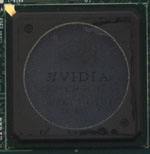
Click here to enlarge.
|
MAP
GeForce4 420 Go 32MB
|
|
|
MAP
GeForce4 410 Go 16MB
|
|
Although the user selectable aspect of PowerMizer is disabled on all laptops currently shipping, NVIDIA provided us with a registry key that would enable this feature on our test laptop. We already discussed what is going on technologically with PowerMizer; what we were curious about was what kind of difference PowerMizer made.
Before we got to testing, we were curious to see what the PowerMizer software control did to the power of our chip. As we mentioned before the PowerMizer slider has three positions: Maximum Performance, Balanced and Maximum Power Savings. Each position on the slider corresponds to a different clock speed that the GeForce4 Go can run at. When an OEM implements PowerMizer, it is up to them what clock speed each stop will correspond to. Since Dell does not support this PowerMizer feature, it was up to NVIDIA this time. In the case of our discrete GeForce4 440 Go, the following clock speeds were used:
Maximum Performance: 220MHz core, 440MHz memory
Balanced: 200MHz core, 400MHz memory
Maximum Power Savings: 100MHz core, 250MHz memory
As can be seen, the clock speed difference between the maximum performance setting and the maximum power savings setting is fairly significant. We are typically left with guessing how much difference a power saving technology makes in a notebook, but thanks to NVIDIA we were able to find out.
Along with the sample notebook that NVIDIA sent us, the company also included an inline test device that allowed us to measure the power consumption of the notebook and see how it altered under different PowerMizer states. The multimeter is hooked into the inline test board that intercepts the power signal between the notebook and the AC adapter. Switching our multimeter to measure amps, we were able to measure the system's current draw in any situation. To eliminate the draw placed on the AC adapter during battery charging, measurements were taken with the system battery removed.
Our system used a 1.6GHz Pentium 4-M chip with enhanced SpeedStep technology. As a result, the test laptop was always throttling between the 1.6GHz and 1.2GHz, just as it would if it were on battery power. We monitored the system current draw under various situations to examine exactly how PowerMizer affected battery life.
To calculate power consumption out of the current draw, we can use p = v*a which states that power consumption in watts is equal to volts times amps. Let's see how power consumption of the GeForce4 440 Go varied depending on PowerMizer state.
To test power drain in a gaming situation, we monitored the current draw during the Unreal Performance Test 2002 build 856 benchmark run at 1024x768x32, a resolution we consider to be a moderate gaming resolution. The maximum current draw was recorded in each of the three PowerMizer states with the following results.
|
Power
Consumption in 3D Gaming
|
|||
|
Maximum
Performance
|
Balanced
|
Maximum
Battery Life
|
|
| Current Draw (amp) |
2.92
|
2.76
|
2.61
|
|
Power Consumption (watt) |
58.4
|
55.2
|
52.2
|
| Power Savings |
-
|
5.8%
|
11.9%
|
|
So, under a stressful 3D gaming situation, PowerMizer provided us with an 11.9% decrease in power consumption. This is clearly a fairly large number considering that 11.9% decrease in consumption is of the whole system's power consumption. In a minute we will get to how this related to real world battery life.
We also tested the various PowerMizer settings while at idle. Current draw of the notebook did vary while in a static 2D mode depending on the PowerMizer setting. Here is what we found.
|
Power
Consumption in 2D
|
|||
|
Maximum
Performance
|
Balanced
|
Maximum
Battery Life
|
|
| Current Draw (amp) |
2.35
|
2.32
|
2.29
|
|
Power Consumption (watt) |
47.0
|
46.4
|
45.8
|
| Power Savings |
-
|
1.3%
|
2.6%
|
|
Obviously, the benefits of PowerMizer are not fully realized in a 2D environment. This is because on top of the user selectable PowerMizer modes, the chip is already doing all it can in a static 2D environment to conserve battery, including clock gating. So, although battery life is slightly increased with PowerMizer enabled in 2D, its benefits are not as pronounced.
Finally we wanted to determine how much the power savings offered by PowerMizer affected real-world battery gaming performance. To find out, we used a program called BatteryMon to monitor the status of our system's battery during gameplay. We monitored the battery life of the system during a 25 minute loop of the Unreal Performance Test 2002 benchmark at 1024x768x32 (again, a popular gaming resolution). BatteryMon allowed us to view not only the percent of battery life left but also the estimated run time remaining as well as a graph of the battery discharge rate.
First we ran the test with PowerMizer set to Maximum Performance mode. After 25 minutes of looping, BatteryMon informed us that 58% of total battery life was left with an estimate of 45 minutes 36 seconds of game play left before the battery completely died.
Next we ran the same test with PowerMizer set to Balanced. This time battery life after the loop was 60% and the program estimated that there was 53 minutes 15 seconds of battery life left.
Finally, the test was done with PowerMizer set at Maximum Battery Life. This test revealed that there was 63% battery left and about 54 minutes 27 seconds.
We can now use this information to estimate exactly how much extra battery life PowerMizer results in under actual gaming situations. The step from maximum performance to balanced mode resulted in a 2% gain in battery life, resulting in (according to BatteryMon) a 7 minute 39 second increase in battery life. Sounds marginal, right? Well, you have to keep in mind that this estimate is taken in a worst case scenario, where the user keeps playing a very intensive 3D game for the entire life of the laptop. What is more likely is that the user will game for about 25 minutes or so, like in our test, and then quit the program to work on other tasks in a 2D environment. This leaves the user with an extra 2% of battery life if he or she was gaming in balanced mode as opposed to maximum performance mode. This 2% in a 2D mode can go a long way.
Going from the maximum performance setting to the maximum battery life setting resulted in a gain of 5% battery life. BatteryMon estimated this as a 8 minute 51 second life gain if all the user was doing was playing games. Again, it is more important to look at the battery life percentage savings. A 5% of extra battery life can go a long way in a 2D mode.
So we see that while the performance savings offered by PowerMizer are not mind blowing, they are in fact fairly impressive. The GeForce4 440 Go gives you the ability to play 3D games with PowerMizer set to maximum performance and realize a longer system run time. But obviously there is more to the GeForce4 440 Go than power savings. Let's see how the chip performs in 3D gaming.
The Test
|
Windows XP Professional Test System |
|||
|
Hardware |
|||
| GeForce4 440 Go Dell Laptop |
Desktop
Testbed
|
||
| CPU(s) |
1.6GHz
Intel Mobile Pentium 4-M
|
1.7GHz
Intel Mobile Pentium 4-M
|
1.6GHz Intel Pentium 4 Northwood |
| Motherboard(s) |
Dell
|
Compaq
845MP DDR
|
MSI
845 Ultra DDR
|
| Memory |
512MB
DDR2100 266MHz
|
256MB
DDR2100 266MHz
|
256MB
PC2100 266MHz
|
| Hard Drive |
30.0GB
|
30.0GB
Hitachi DK23DA-30F
|
IBM
Deskstar DPTA-372050 20.5GB 7200 RPM Ultra ATA 66
|
| CDROM |
Toshiba
DVD/CDRW
|
Toshiba
DVD/CDRW
|
Phillips
48X
|
| Video Card(s) |
GeForce4
440 Go 64MB DDR
|
ATI
Mobility Radeon 7500 64MB DDR
|
NVIDIA
GeForce4 MX 460
NVIDIA GeForce4 MX 440 NVIDIA GeForce2 MX |
| Ethernet |
Onboard
|
Intel
PRO/100 Onboard Ethernet Adapter
|
Linksys
LNE100TX 100Mbit PCI Ethernet Adapter
|
|
Software |
|||
|
Operating System |
Windows XP Professional |
||
| Video Drivers |
NVIDIA
28.35
|
ATI
6.13.10.6045
|
NVIDIA
29.42
|
|
Benchmarking Applications |
|||
|
Unreal
Performance Test 2002 build 856 |
|||
As you can see, we were forced to compare the video the video chips in two different systems. The system that was used for the Mobility Radeon 7500 has a 100MHz speed advantage over the system used for testing the GeForce4 440 Go. At the same time, the GeForce4 440 Go system has 256MB more memory than the Mobility Radeon 7500 test setup. Overall, the processor speed will make a larger difference in gaming than the increase from 256MB to 528MB of memory.
Performance - Unreal Performance Test 2002
|
Our first glimpse at the performance of the GeForce4 440 Go came with Unreal Performance Test 2002. At 640x480x32 we see that the GeForce4 440 Go in our 1.6GHz test system actually outperformed the Mobility Radeon 7500 in a faster 1.7GHz system; a trend we would see continue throughout the testing process. We also see the GeForce4 440 Go performs only 5.5% slower than the desktop GeForce4 MX 440 on a similarly configured testbed.
Turning PowerMizer on to balanced mode resulted in a performance cutting in half over the maximum performance mode, while the battery mode decreased performance 41.9% compared to the balanced mode. Clearly the penalties involved with changing PowerMizer from its default state are fairly large, but the modes do create more battery run time.
|
At 800x600x32, again the GeForce4 440 Go in its maximum performance state outperforms the Mobility Radeon 7500 in a faster system. This time, the GeForce4 440 Go beat the Mobility Radeon 7500 by 13.8%. Like before, performance of the GeForce4 440 Go did drop with PowerMizer enabled but that is the price one has to pay. Keep in mind that in the balanced mode, the GeForce4 440 Go still readily outperforms a desktop GeForce2 MX by 75.6%.
|
At 1024x768x32, the GeForce4 440 Go outperforms the Radeon Mobility 7500 by 9.2%.
|
Bumping the resolution up to 1280x1024x32 changes things up slightly. First off, the gap between the desktop GeForce4 MX 440 and the GeForce4 440 Go shrinks to only 3.4%. Next we see that the Mobility Radeon 7500 is finally able to slightly outperform the GeForce4 440 Go. The difference between the two graphics chips is not noticeable, but keep in mind that the Radeon system was running on a 100MHz faster CPU. It is likely that performance of the Mobility Radeon 7500 would once again fall below the GeForce4 440 Go if both were in the same system.
Performance of the GeForce4 440 Go does drop off when PowerMizer is enabled. In the balanced setting the chip runs 30.8% slower than the chip in maximum performance mode and 82.8% slower in maximum battery mode compared to the balanced mode.
|
This marks the first time that we have been able to test a mobile graphics solution at the high resolution of 1600x1200x32. Previously we were limited by the unit's LCD display, but the Dell unit we received featured a UXGA screen that ran at 1600x1200x32. Since we were not able to run the Mobility Radeon 7500 at 1600x1200x32 on the built in panel, the chip is not on the performance graphs at this resolution.
As you can see, the GeForce4 440 Go performs almost identically to the desktop GeForce4 MX 440 when in Unreal Performance Test 2002 at 1600x1200x32. The two are seemingly identical at this resolution. The chip in both the balanced mode and the battery mode still outperformed the desktop GeForce2 MX, meaning that it was still faster than the GeForce2 Go solutions out there.
Performance - Serious Sam: The Second Encounter
|
We were quite impressed with the GeForce4 440 Go's performance in Serious Sam: The Second Encounter at 640x480x32. At this resolution the chip was able to put out 110.8 frames per second, making it 7.3% faster than the Mobility Radeon 7500 system and maintaining its crown as mobile performance king. Again, performance of the mobile chip was not far off the desktop GeForce4 MX 440.
One thing we first noticed while running the system in Serious Sam: The Second Encounter was that frame rates were limited when PowerMizer was switched to anything but Maximum Performance mode. Frame rates in the Balanced mode were limited to 60FPS while frame rates would not break 30FPS while in Maximum Battery mode. NVIDIA implemented this feature to prevent unnecessary battery drain. By limiting how much the GPU is doing at a given time, NVIDIA can save power consumption of the chip.
As a result, our performance in both balanced and maximum battery life mode are limited at 640x480x32. They did provide enough power to play the game without a glitch, however.
|
We were equally impressed with the GeForce4 Go 440's performance in Serious Sam at 800x600x32. The chip gained an even larger performance advantage over the Mobility Radeon 7500. Here, the GeForce4 Go 440 performed 10.7% faster than the ATI product. Again we find that in balanced as well as maximum battery mode the GeForce4 Go 440 is limited to 60FPS and 30FPS respectively.
|
The performance advantage of the GeForce4 440 Go over the Mobility Radeon 7500 starts to level off at 1024x768x32. This time NVIDIA's mobile part performed 6.6% faster than ATI's. 1024x768x32 marks the first time that the GeForce4 Go 440 is not limited in balanced mode by the frame rate limiter: the chip is down to 46.5FPS from its max of 60. In balanced mode, the chip still remains at NVIDIA's imposed limit of 30FPS. Even at 1024x768x32, Serious Sam: The Second Encounter is very playable with the GeForce4 Go 440 in maximum battery life mode.
|
1280x1024x32 sees the GeForce4 440 Go beaten by the Mobility Radeon 7500, although by a small 1.9%. The speed advantage the Mobility Radeon 7500 is able to gain at this resolution is almost certainly a result of the faster CPU this system was running on (1.7GHz compared to the GeForce4 440 Go's 1.6GHz notebook). There is little doubt in our mind that an apples to apples comparison at this resolution would show the GeForce4 440 Go on top yet again.
Pushing the resolution up this high also decreased the performance of the chip in the PowerMizer modes. In balanced mode, the chip performs 51.7% slower than the chip in high performance mode and in power saving mode the chip is exactly half as fast as the the chip in balanced mode.
|
Pushing the resolution up to 1600x1200x32 did not leave us disappointed. The GeForce4 440 Go remained on par with the desktop GeForce4 MX 440, about 27.2% slower than the GeForce4 MX 460. The chip was still able to output slightly over 30FPS, keeping the game playable. Even in balanced mode, performance is not so bad: 37.4% slower than chip in maximum performance mode. Maximum battery mode does leave the chip fairly crippled, however.
Performance - Jedi Knight 2: Jedi Outcast
|
A new game to our mobile review performance analysis section, we did not have Jedi Knight 2: Jedi Outcast scores for the Mobility Radeon 7500 system. We can hypothesize, however, that the GeForce4 440 Go would continue to outperform the Mobility Radeon 7500 as it has in the majority of other tests.
The performance of the mobile chip was only 5.9% off the performance of the desktop GeForce4 MX 440. With PowerMizer set to a setting other than maximum performance, frame rate was limited in an effort to save power.
|
Frame rates really do not fall off when going from 640x480x32 to 800x600x32. As we have noted before, Jedi Knight 2 is a very CPU intensive game, so increasing the resolution slightly does not necessarily decrease performance. The standings of the cards remain similar, with only the desktop GeForce2 MX falling in performance significantly.
|
Again, performance does not really fall off at this resolution. We can see that at over 70FPS, the GeForce4 440 Go is more than able to play Jedi Knight 2. Even with PowerMizer set to balanced or battery mode, performance should still be acceptable (although on the border in maximum battery life mode).
|
Finally we see the systems tested hit a video card bottleneck and not a CPU one. Performance of everything with the exception of the desktop GeForce4 MX 460 falls off at 1280x1024x32. The GeForce4 440 Go comes in at 9.0% slower than the GeForce4 MX 440 and 64.8% slower than the GeForce4 MX 460. Balanced mode performance is 49.7% slower than maximum performance mode and maximum battery life mode is 57.7% slower than balanced mode.
|
At 1600x1200x32 the GeForce4 440 Go performs only 9.0% slower than the desktop GeForce4 MX 440: not bad considering the extremely high resolution we were benchmarking at. Playablity is iffy under balanced mode and not really possible in battery mode. Then again, both of these modes are faster than the not so old GeForce2 MX that many still have in their system. Not bad for a mobile chip, not bad at all.
Competition is really only meaningful if the competing product poses a threat. If an unknown company would have attempted to enter the mobile market by releasing a chip that was easily dominated by an existing chip, the dominating company would only continue to rule the market. This is not the case however. NVIDIA is not an unknown company and the GeForce4 440 Go is certainly not a low performing chip.
There is no question that the GeForce4 Go series release has left ATI a bit unsettled. Not only do the GeForce4 Go chips contain power saving features that do make a real world difference, they also contain enough power to dethrone the ATI Mobility 7500 as the leading mobile graphics solution. NVIDIA has stepped the performance bar up a notch and ATI has to be getting worried.
As it stands right now, the GeForce4 440 Go holds the crown as the most powerful mobile gaming solution out there today. The GeForce4 440 Go in maximum performance mode has the ability to play 3D games as well as or better than a large number of desktop systems out there, making the transition to a notebook all the more easy. In fact, the discrete GeForce4 440 Go performs very similarly to the desktop GeForce4 MX 440; an impressive feat.
In balanced or maximum battery mode, the GeForce4 440 Go has the ability to play a good number of games at reasonable resolutions while increasing battery life. Although the battery savings may not be enormous, they do result in real world battery life increases. Using one of the lower PowerMizer modes makes perfect sense for those who want to do a bit of mobile gaming on the road but still want battery life left over to work on a document or spread sheet.
Competition like this is what we like to see best. Not only does the current battle going on in the mobile arena force both ATI and NVIDIA to stay on their toes to maintain or gain market share, it also provides great solutions to the consumer. Although only Dell and Toshiba have announced laptops based on the GeForce4 Go series chips, NVIDIA promises more are coming. At the same time, ATI has a number of large OEMs that use the Mobility Radeon 7500, including Dell and WinBook.
We love to see a good battle and the one being waged on the mobile graphics front is just beginning to warm up. Trust us.


